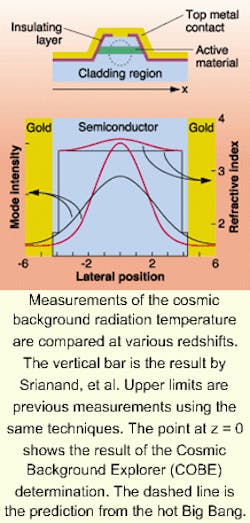The existence of cosmic microwave background radiation (CMBR) in all directions of the sky is well-established evidence that supports the Big Bang model of the early universe. Although the temperature of the local CMBR was determined with high precision in the early 1990s, the presence of radiation at earlier times has never been proven directly, until now. Astronomers in India, France, and Germany have announced a finding of the CMBR temperature from absorption in the visible spectrum of a distant quasar at high redshift, evidence that the universe has cooled since its early beginnings, further lending support to Big Bang cosmology.
If CMBR is relic radiation from the Big Bang, its temperature should increase with increasing redshift. Currently, (redshift z = 0), the temperature has been determined by the Cosmic Background Explorer (COBE) to be TCMBR(0) = 2.726 ± 0.010 K.1 The temperature of the CMBR black-body spectrum is predicted to increase linearly with redshift as TCMBR(z) = TCMBR(0) · (1 + z). The most distant sources in the universe, quasars, are also those with the highest redshifts. In principle, the background temperature can be determined using measurements of the relative populations of atomic fine-structure levels, which are excited by the background radiation. The absorption of these atomic species can be measured in the spectra of distant quasars and used to constrain TCMBR at high redshift. Previous measurements have achieved only upper limits, thus still formally permitting the radiation temperature to be constant with increasing redshift.
Now, Raghunathan Srianand with the Inter University Center for Astronomy and Astrophysics (Pune, India) and colleagues claim to have established a lower limit for the temperature. The team used the Ultraviolet and Visible Echelle Spectrograph (UVES), mounted on the European Southern Observatory (Paranal, Chile) KUEYEN 8.2-m telescope to obtain a high-spectral resolution spectrum of the quasar PKS1232+0815 with emission redshift zem = 2.57. Absorption lines of neutral carbon atoms from an isolated cloud of gas at z = 2.3371 were detected in front of the quasar. The carbon lines, together with absorption lines of singly ionized carbon in its excited fine-structure level, and absorption lines of molecular hydrogen, were all used to derive the particle density and ultraviolet radiation flux of the cloud. The authors claim this is the first time the three fine-structure levels of the ground state of carbon have been detected at high redshift.
Taking into account all likely processes, an upper limit on TCMBR was obtained by assuming that the CMBR is the only excitation process at work. These constraints enabled the team to determine that the background radiation was indeed warmer in the past, with a temperature between 6.0 and 14.0 K at z = 2.33771 (see figure). The scientists claim that this measurement demonstrates for the first time that the cosmic radiation existed at earlier times and has a higher temperature than today. In the standard Big Bang cosmological model, this strongly supports the theory that CMBR is relic radiation left over from the early expansion of a hot universe. More analysis over a wide redshift range will further provide information on the evolution of the cosmic microwave background.
REFERENCE
- J.C. Mather et al., Astrophys. J. 420, 439 (1994).

